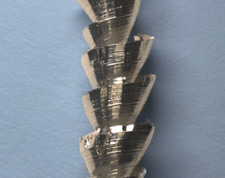Home | Glossary | Resources | Help | Contact Us | Course Map
Archival Notice
This is an archive page that is no longer being updated. It may contain outdated information and links may no longer function as originally intended.
Tool Manufacture
Tools are manufactured by shaping a piece of metal into a tool. Excess material is removed until the tool meets the desired specifications.
Common cutting operations using machine tools include these:
Common metal-forming techniques, other than machine tool operations include the following:
Some modern metal machining techniques:
- Electrical discharge machining (EDM)
- Laser machining
- Electrochemical machining (ECM)
- Chemical machining (etching)
- Hydrodynamic machining (HDM)
- Ultrasonic machining
- Electron beam machining (EBM)
Cutting Operations
Metal-forming operations, using conventional machine tools, involve the removal of metal using a cutting tool of a greater hardness than the workpiece (the piece of metal being formed). When cutting tools are used on metal, the cutting edge of the tool brings a large amount of force to bear at a very small point on the workpiece. When that amount of force exceeds the forces that hold the crystalline grain structure of the metal together, that structure fails along the edges of the metallic crystals.
The cumulative effect of these failures in the crystalline grain structure is to produce chips of metal of various types:
| Types of Metal Chip | |
| Chip Type | Description |
|
Continuous chips (long ribbons of metal) |
Typically found in machining a ductile metal with a sharp cutting tool, resulting in a fine surface |
|
Discontinuous chips (segmented chips) |
Break up into particles; associated with brittle metals and a coarser result on the surface of the workpiece |
|
Continuous chips with a built-up edge |
Accumulate tiny particles that weld to the workpiece, producing coarse surfaces on the workpiece. This often occurs if the cutting tool begins to dull |
The removal of these chips results in a machined surface bearing unique characteristics subclass or individual.
The relative fineness or coarseness of this surface depends on variables that can be controlled by the machinist, including these:
- Brittleness or ductility of the workpiece (e.g., cast iron is brittle, brass is very ductile)
- Quality of the cutting tool
- Adjustment of the cutting tool for the depth of the cut
- Sharpness of the cutting tool
- Speed at which the workpiece moves relative to the cutting tool (feed rate)
- Angle of the cutting tool relative to the workpiece
- Speed of the cutting tool
- Condition of the edge of the cutting tool
- Temperature of the workpiece and cutting tool (usually controlled using coolant fluids)
In most operations, a mechanical device called a jig is used to hold the workpiece and guide the tool as it shapes the metal.
Cutting Tools
The various cutting tools use the chip-forming process. The cutting edges of the tools are arranged in a wide variety of single-point and multi-toothed configurations, depending on the specific metal removal task.
Additional Online Courses
- What Every First Responding Officer Should Know About DNA Evidence
- Collecting DNA Evidence at Property Crime Scenes
- DNA – A Prosecutor’s Practice Notebook
- Crime Scene and DNA Basics
- Laboratory Safety Programs
- DNA Amplification
- Population Genetics and Statistics
- Non-STR DNA Markers: SNPs, Y-STRs, LCN and mtDNA
- Firearms Examiner Training
- Forensic DNA Education for Law Enforcement Decisionmakers
- What Every Investigator and Evidence Technician Should Know About DNA Evidence
- Principles of Forensic DNA for Officers of the Court
- Law 101: Legal Guide for the Forensic Expert
- Laboratory Orientation and Testing of Body Fluids and Tissues
- DNA Extraction and Quantitation
- STR Data Analysis and Interpretation
- Communication Skills, Report Writing, and Courtroom Testimony
- Español for Law Enforcement
- Amplified DNA Product Separation for Forensic Analysts




